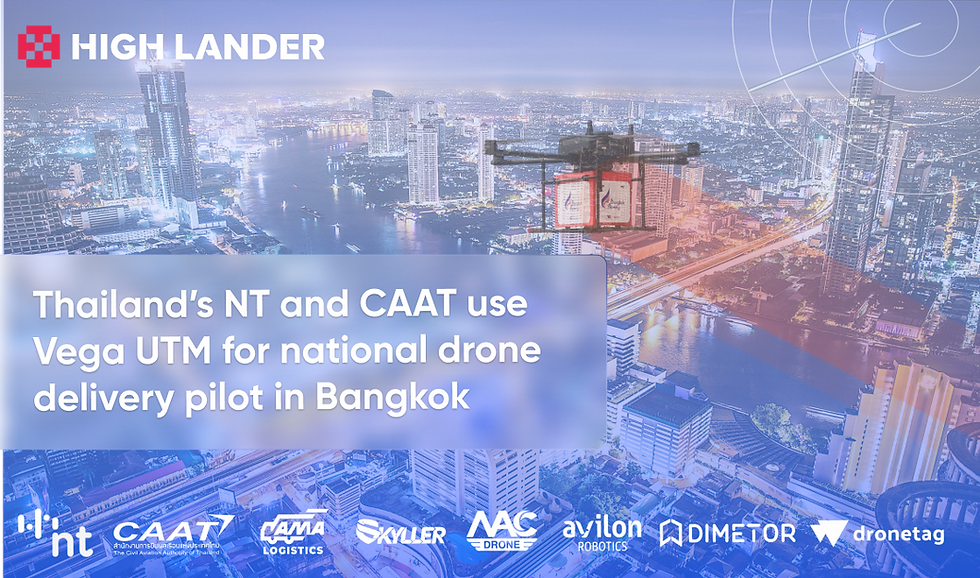High Lander Launches Vega CIS: A Common Information Service Providing Geo-Awareness Management and Data Sharing for Airspace Managers
- Simon Golstein
- May 15
- 3 min read
Vega CIS is a software solution enabling airspace managers to manage constraints and share geo-awareness data with airspace participants, creating full ecosystem interoperability within U–spaces and harmony between manned and unmanned aircraft.

Lisbon, May 2025 - High Lander Aviation, a leading provider of drone fleet management (DFM) and UAS traffic management (UTM) services, has unveiled Vega CIS, an advanced Common Information Service.
Vega CIS is an intuitive desktop-based platform enabling airspace managers such as ANSPs, air traffic managers (ATMs) and aviation authorities to create airspace constraints, perform Dynamic Airspace Reconfiguration (DAR), and share geo-awareness data in real time with UTM/USSP service providers and unmanned aerial system (UAS) operators. An associated mobile app provides airspace data to end-users.
By giving aviation authorities ownership of dynamic UAS-enabled airspaces, and by enabling ecosystem-wide data synchronization both directly and via discovery and synchronization service (DSS), Vega CIS provides the basis for digital airspaces where UAS can operate at scale in safety, even when under the control of diverse operators and service providers. Furthermore, it enables authorities to adjust UAS permissions in real-time according to air traffic control (ATC) data and flow, preventing conflicts between UAS and manned aircraft.
“Data sharing is the cornerstone of safe aviation,” said Alon Abelson, founder and CEO of High Lander. “Vega CIS exponentially simplifies the process of creating, adjusting and sharing airspace permissions while forging a vital data link between airspace authorities and all participants in the UAS ecosystem - in other words, it’s the key to the future of aviation.”
The constraint management capabilities of Vega CIS streamline complex processes that until now had required considerable time, expertise and red tape to complete. Through a single dashboard, aviation authorities can create three types of airspace: info zones, where UAS flight plans will be automatically approved in accordance with UTM-powered deconfliction and prioritization protocols; restricted zones, where authorities customize permissions based on conditions and official approvals; and
prohibited zones, where UAS flight plans will be automatically denied. Airspace restrictions can be customized in granular detail according to variables including UAS size and class, mission details and regulatory approvals. Authorization can also be granted manually when required.
Furthermore, Vega CIS’ innovative NOTAM engine converts coded text-based notices into visualized airspace constraints on the dashboard map, making another time-consuming process far more achievable and helping ensure that geo-awareness data remains up to date.
“Large-scale UAS operations, including public safety drones, advanced air mobility networks and urban aerial delivery services, are not feasible in complex airspaces without dedicated digital infrastructure enabling ecosystem-wide coordination and regulatory oversight,” added Abelson. “High Lander is proud to answer the call and enable this exciting new era of aviation with Vega CIS.”
Vega CIS was designed in accordance with the European Union Aviation Safety Agency’s (EASA) Commission Implementing Regulation 2021/664, and follows international standards including those of the UTM ConOps of the International Civil Aviation Organization (ICAO), the American Society for Testing and Materials (ASTM), and the European Organisation for Civil Aviation Equipment standards (EUROCAE), enabling the creation of U-spaces in airspaces throughout the European Union and beyond.
Vega CIS is designed to be agile, enabling continual updates as regulations and standards develop, while also offering additional services such as an e-registration module, and airspace density and population data sharing. The system has been thoroughly field-tested and approved by a national civil aviation authority in sandbox operations, signaling its readiness for real-world deployment.
The solution joins the solutions of Vega Hub, comprising Vega UTM, High Lander’s proprietary UAS traffic management solution, and Vega Fly, a mobile app for drone operators to receive airspace data and flight plan authorization. Together, they provide an end-to-end suite of software solutions for the management of UAS traffic.



Great to see High Lander Aviation launching Vega CIS impressive how real-time geo-awareness and dynamic airspace constraints are being tackled. As someone using an Online Coursework Writer UK service, I know how important accurate, timely information is this certainly sets a high standard.
Many students juggling multiple deadlines often wonder who
can someone do my assignment for me with MyAssignmenthelp when academic pressure rises. MyAssignmenthelp highlights the importance of time management, structured planning, and steady progress to handle such challenges effectively. Instead of last-minute stress, students can focus on understanding requirements, setting small goals, and maintaining quality across subjects. By learning how to approach tasks strategically, they can meet deadlines without compromising on originality or accuracy. The focus remains on achieving balance—working smart, staying consistent, and ensuring that every completed assignment reflects dedication and understanding.
This is an exciting launch from High Lander Aviation Vega CIS sounds like a game-changer for UAS traffic management, especially with its real time geo awareness sharing and dynamic reconfiguration features. Streamlining airspace constraints and integrating with existing UTM systems like Vega Hub could really accelerate safe drone operations at scale, from urban deliveries to public safety missions. As someone who's always on the lookout for innovative tech that bridges digital ecosystems, I appreciate how this fosters interoperability without the usual regulatory headaches.
On a somewhat tangential note, while exploring airspace apps for field ops, I stumbled upon the Vyvymanga official app, which offers surprisingly robust geo mapping tools for creative pros perfect for visualizing drone routes or even overlaying…